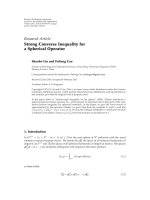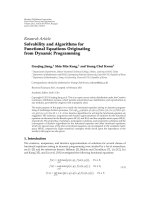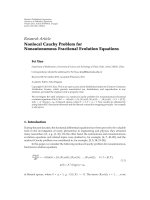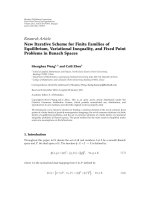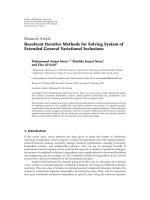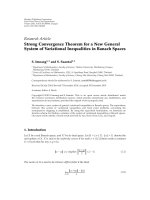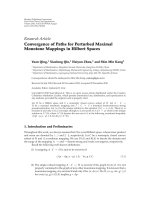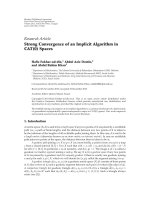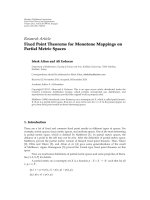Báo cáo hóa học: " Research Article Cross-Layer Handover Scheme for Multimedia Communications in Next Generation Wireless Networks" potx
Bạn đang xem bản rút gọn của tài liệu. Xem và tải ngay bản đầy đủ của tài liệu tại đây (869.02 KB, 10 trang )
Hindawi Publishing Corporation
EURASIP Journal on Wireless Communications and Networking
Volume 2010, Article ID 390706, 10 pages
doi:10.1155/2010/390706
Research Article
Cross-Layer Handover Scheme for Multimedia Communications
in Next Generation Wireless Networks
Yuliang Tang,
1
Chun-Cheng Lin,
2
Guannan Kou,
1
and Der-Jiunn Deng
3
1
Department of Communication Engineering, Xiamen University, Fujian 361005, China
2
Department of Computer Science, Taipei Municipal University of Education, Taipei 10048, Taiwan
3
Department of Computer Science and Information Engineering, National Changhua University of Education, Changhua, Taiwan
Correspondence should be addressed to Der-Jiunn Deng,
Received 27 February 2010; Accepted 14 August 2010
Academic Editor: Liang Zhou
Copyright © 2010 Yuliang Tang et al. This is an open access article distributed under the Creative Commons Attribution License,
which permits unrestricted use, distribution, and reproduction in any medium, provided the original work is properly cited.
In order to achieve seamless handover for real-time applications in the IP Multimedia Subsystem (IMS) of next generation
network, a multiprotocol combined handover mechanism is proposed in this paper. We combine SIP (Session Initiation Protocol),
FMIP (Fast Mobile IPv6 Protocol), and MIH (Media Independent Handover) protocols by cross-layer design and optimize those
protocols’ signaling flows to improve the performance of vertical handover. Theoretical analysis and simulation results illustrate
that our proposed mechanism performs better than the original SIP and MIH combined handover mechanism in terms of service
interruption time and packet loss.
1. Introduction
In next generation wireless system, access networks can
be carried out by different technologies, such as WiFi,
WiMAX and UMTS, while the core network infrastructure is
established on an all-IP-based network. There have existed
a variety of applications for next generation wireless system,
in which the multimedia service is one of main applications
[1]. However, the characteristics of wireless systems provide
a major challenge for reliable transport of multimedia since
it is highly sensitive to interference and link or channel
change, which may cause delay, packet loss, and jitter. The
wireless networks have to cope with this lack of Quality of
Service (QoS) guarantees [2]. For improving the QoS, many
studies investigate how to optimize the system scheduling
scheme of utilizing available network resources [3, 4]. The
IP Multimedia Subsystem (IMS) is an architectural frame-
work for delivering IP multimedia services, which applies
Session Initiation Protocol (SIP) to controlling multimedia
communication sessions. SIP can provide IP mobility by
the REINVITE signaling. However, SIP has a longer end-
to-end signaling delay which may cause frequent disruption
for real-time applications in node motion. Therefore, as the
nodes move among heterogeneous wireless networks, one of
the greatest challenges is how to provide fast and seamless
mobility support.
Media Independent Handover (MIH) standard [5]was
proposed for solving the above problem. Some researches
(see, e.g., [6, 7]) had been done by using MIH to improve
the SIP-based node mobility handover process in vertical
handover. In addition, MIH is also used to assist the
Mobile IP-(MIP-) based handover process. Fast Mobile IPv6
Protocol (FMIP) is an extension to MIPv6 designed for
eliminating the standard MIP handover latencies [8] and is
a combined SIP+MIH handover architecture by cross-layer
design. A combined FMIP+SIP handover architecture can
befoundin[9]. However, in fact, the improvement of the
handover performance for the previous approaches is limited
when only one or two kinds of protocols are combined to
solve the handover problem. Hence, a better way to solve the
problem is to design a combination of more layer protocols
by cross-layer design. In this paper, our interests focus on
how to accelerate the handover process.
Handover occurs when a communicating node moves
from one network to another. It can be classified into two
modes: make-beforebreak and break-beforemake,inwhich
the former connects to the new network before the node
tears down the current connected network, while the latter
2 EURASIP Journal on Wireless Communications and Networking
just does the other way. The make-beforebreak mode is
more complicated to be implemented, but have a better
performance on end-to-end delay and packet loss. In this
paper, an integrated scheme of combining FMIP, SIP and
MIH signaling is proposed to optimize the performance of
vertical handover on make-beforebreak mode.
The rest of this paper is organized as follows. Section 2
introduces the relevant protocols and related work. The pro-
posed handover mechanism is given in Section 3. Section 4
shows the simulation results and Section 5 concludes this
paper. At the end, in order to facilitate the understanding
of this paper, some key terminologies used in this paper are
listed in the Abbreviations.
2. Background
2.1. Relevant Protocols. SIP is a signaling protocol, which
is widely used for controlling multimedia communication
sessions such as voice and video calls over IP. It supports
terminal mobility when a mobile node (MN) moves to a
different location before a session establishment or during
the middle of a session. Before the REINVITE signaling
of SIP, the correspondent node (CN) can send data to the
MN prior to the registration of MIP. However, even though
working with MIP, SIP still needs a new care of address
(NCoA) whose configuration spends more time.
IEEE 802.21, a.k.a., Media-Independent Handover
(MIH), is designed to optimize the handover between
heterogeneous networks so that the continuity of transparent
services comes true. The MIH consists of a signaling
framework and the triggers that make available information
from the lower layers (MAC and PHY) to the higher layers
of the protocol stack (network layer to application layer).
Furthermore, MIH is responsible for unifying a variety of
L2-specific technology information used by the handover
decision algorithms so that the upper layers can abstract the
heterogeneity that belongs to different technologies.
The core idea of MIH is the introduction of a new
functional module—Media Independent Handover Func-
tion (MIHF), which operates as a glue of L2 and L3 (see
Figure 1). MIHF accesses various MAC layers in hetero-
geneous networks, controls them through different service
access points (MIH
LINK SAP), and provides to up-layer
users a media independent service access point (MIH
SAP),
such as FMIP, SIP. It is accomplished through three services:
media-independent event service (MIES), media indepen-
dent information service (MIIS), and media-independent
command service (MICS).
In MIES, the MIH user can be notified a certain event
by the local or remote MIHF. The MIH events are made
available to upper layers through the MIH
SAP, such as
MIH
Link Up (the L2 connection is established, and the link
is available for the user), MIH
Link Going Down (the loss
of the L2 connection is imminent), and MIH
Link Down
(the L2 connection is lost). The MIIS is a function for MIHF
which discovers the information of available neighboring
networks to facilitate the network selection and handover.
It provides mostly static information. The MICS gathers the
Handover
decision
module
SIP/applications
MIP/FMIP
MIH
SAP
MIHF
MIH
LINK SAP
802.11u
802.16g
UMTS
Figure 1: Multiprotocol architecture in heterogeneous networks.
information on the status of connected links and the connec-
tivity decision to the lower layers by offering commands to
upper layers (e.g., scanning available networks). Therefore,
the MICS commands control, manage, and send actions to
lower layers, and can be issued by both local and remote
MIH users. There is an IETF workgroup-MIPSHOP, which
addresses an L3 transport mechanism for the reliable delivery
of MIH messages between different access networks.
MIPv6 was designed to enable MNs to maintain con-
nectivity when they move from one network to another.
However, the latency caused by the MIPv6 operation is
unacceptable for real-time applications. To overcome this
problem, fast handovers for the Mobile IP protocol have been
proposed by the Mobile IP working group of the IETF, which
enables an MN to connect to a new point of attachment
more rapidly. Fast Mobile IPv6 (FMIP) applies an unclearly-
defined link layer event to triggering the mobile node’s
beginning handover process while the MN still connects to
the previous link. The MN exchanges the RtsolPr/PrRtAdv
(Router Solicitation for Proxy Advertisement and Proxy
Router Advertisement) message with the previous access
router (PAR) to obtain the target access router’s MAC, IP
addresses, and valid prefix.
By using the retrieved information, the MN formulates
a prospective new care of address (NCoA) and sends a
fast binding update (FBU) to the PAR. The purpose of
the FBU is to authorize the PAR to bind previous care of
address (PCoA) to NCoA, so that arriving packets can be
tunneled to the new location of the MN. The PAR sends
a Handover Initiate (HI) message to carry the NCoA to
the NAR which determines whether NCoA is unique on
the new link interface or not by duplicate address detection
(DAD). The PAR will return the available address in the
FBack. After attaching to the new network, the MN sends
an unsolicited neighbor advertisement (UNA) immediately,
so that the buffered packets at NAR can be forwarded to the
MN right away.
The tunnel created between the two routers remains
active until the MN completes the binding update with its
correspondent node. Note that the buffer packet to NAR
can extremely reduce the packet loss but the service will be
interrupted between FBU and UNA. If the FMIP is triggered
to begin the handover process timely, the handover delay can
be reduced a lot, but the protocol is not specific to the trigger
EURASIP Journal on Wireless Communications and Networking 3
method. This problem can be overcome by introducing MIH.
The MIH provides intelligence to the link layer such as the
link going down triggers to wake up FMIP.
2.2. Related Work. In [10, 11], some schemes of integrating
SIP and MIP have been proposed to optimize the mobility
management. For achieving the fast handover procedure,
cross-layer schemes have been investigated widely. Among
them, some use MIH to facilitate handover while others do
not. In [12], an integrated mobility scheme is proposed to
combine the procedures of FMIP and SIP. But without MIH,
the real-time requirement of L2 trigger is still an unresolved
problem.Theschemein[13] suggests to combine MIH and
SIP, but, even if it claims to make handover before breaking
the link, it does not consider the packet loss while the old link
quality becomes poor. The schemes in [14, 15] use existing
MIH services to optimize the FMIP. MIH is used to reduce
the time of discovering Access Router (AR) by using MIIS
to retrieve necessary information of neighboring network
without using the RtSolPr/PrRtadv messages. Especially
in [15], ARs control the data forwarding (to MN) with
the subscribed triggers of MIH events (MIH
Link Up and
MIH
Link Down). However, additional MIHF operations in
handover may increase the system signaling load. Without
simulation, it is hard to say that these schemes indeed
improve the performance of handover. In [16], a mechanism
is proposed to combine SIP, FMIP and MIH. However,
the work is limited in 802.16 networks, and there is no
comparable simulation result either.
2.3. The O SM. In next generation wireless networks, the
network infrastructure is heterogeneous and all-IP. There
are multiple protocols and functional modules to support
the handover (see Figure 1). Note that the conventional
approaches for improving the handover performance are
combined by SIP and MIH, while our proposed handover
approach is a combination of SIP, FMIP and MIH. For
comparison, we briefly describe the original SIP and MIH
combined handover mechanism (OSM), which is a make-
beforebreak handover mechanism. The OSM provides the
IP mobility between heterogeneous networks as illustrated
in the message flow of Figure 2. Recalling that IP mobility is
achieved by the REINVITE signaling of SIP, the MN sends
the REINVITE signaling to its corresponding node (CN)
to reestablish the communicational session with the new
IP address. Before the handover process begins, the MN
retrieves the prefix of the NAR through the IS in advance.
In order to complete handover process before previous link
down, the new IP address configuration and the REINVITE
signaling of SIP are triggered by MIH’s link going down event
(LGD) in OSM. After exchange Router Solicitation (RS) and
Router Advertisement (RA) signaling, the MN connects to
the NAR.
3. Proposed Mechanism
In order to achieve seamless handover for IP multimedia
subsystem in heterogeneous networks, we propose the FMIP-
auxiliary SIP and MIH handover mechanism (FASM), which
is based upon the architecture of Figure 1. The idea behind
the FASM is to introduce the FMIP to the SIP and MIH com-
bination architecture. In [17], a handover decision module
(HDM) was proposed to handle the network management,
which decides a handover target network. Through the
MIH
SAP interface, the HDM registers with the local MIHF
to become an MIH user. When the link layer event happens,
the HDM can obtain the event notification from MIHF.
Different from [17], our main concern in FASM is on how
to use the cross-layer information to achieve a fast handover,
rather than how to select a handover target network any
more. Therefore, it is assumed that the link layer handover
decision is always valid and the HDM takes charge of
choosing the target network.
3.1. Handover Process. In FASM, the fast handover process is
achieved by the following three main steps. See also Figure 3
which illustrates the signaling process in FASM. In the first
step, the LGD (MIH
Link Going Down) event is used to
trigger the handover action, while the MIIS is used to tackle
the issues related to the discoveries of radio access discovery
and candidate AR discovery. The second step is started after
the HDM chooses out the target network. In the second step,
the FMIP operation is triggered by the LUP (MIH
Link Up)
event. The operations of HI, HAck, FBack and UNA signaling
are used not only for the MN to configure its NCoA in
advance but also for the ARs to buffer the packets that
are forwarded to NCoA. After the NAR receives the UNA
signaling, it can serve the MN immediately. The third step
is the MIP Bind Update operation mixed with SIP, including
SIP REREGISTER and SIP REINVITE signaling. In FASM,
the SIP proxy server and the MIPv6 home agent (HA) are
mixed together as an integrated logical entity which is the
SIP Server (SS) in Figure 3.
3.2. Details of Signaling Flows
3.2.1. Event Registration. At the early beginning, the
HDM registers an interesting MIH Event (i.e., L2 trig-
gers) to the local MIHF. This task can be done by the
MIH
Event Subscribe.request/response primitives. Accord-
ing to different MIH Event triggers, the HDM will control
FMIP and SIP in different ways as follows: LGD will trigger
the HDM to turn on the interface to connect the target
network; LUP will trigger the HDM to tell the FMIP to send
FBU to PAR and begin the other FMIP handover process
sequentially; LD (MIH
Link Up) will tell the HDM that
the make-beforebreak handover is over, and the previous
interface can be closed.
3.2.2. Retrieval of Neighboring Network Information from the
IS. In FASM, the functions of RtSolPr/PrRtAdv messages
in the standard FMIP are replaced by the MIH
Get Infor-
mation request/response messages, so the RtSolPr/PrRtAdv
messages can be deleted in FASM, and thereby the signal-
ing load can be reduced. The MN obtains the network’s
neighboring information by the MIH
Get Information
request/response messages, and stores the information
4 EURASIP Journal on Wireless Communications and Networking
IS
SIP proxy server
MN PAR NAR CN
MIH
Get Information request
MIH
Get Information response
Pre-session
LGD
New IP
SIP BU
Connect to new BS
RS
RA
Disconnect
SIP-REINVITE
DATA(200OK)
Figure 2: Signaling flows of the OSM.
IS SIP proxy server
MN PAR NAR CN
MIH
Get Information request
MIH
Get Information response
Pre-session
LGD
SIP BU
Turn on interface
Connect to new BS
LUP
FBU
FBack
HI
HAck
FBack
UNA
SIP-REINVITE
DATA(200OK)
LD
Tur n off interface
Figure 3: Signaling flows of the FASM. Dotted line depicts buffering and forwarding packets.
EURASIP Journal on Wireless Communications and Networking 5
about the networks in its cache. The MIH
Get Information
request/response can be done much before the L2 trigger
(i.e., MIH
Link Going Down), unlike the original FMIP in
which the RtSolPr/PrRtAdv only occurs after L2 triggers.
3.2.3. Network Selection and Sw itching Link. When the signal
strength of Base Station (BS) becomes poor, the HDM will be
notified that the current connecting link is going down (i.e.,
LGD event). Then the HDM chooses the target handover
network by using the neighboring network information in
the MN’s cache, and turns on the corresponding interface.
Therefore, the MN can connect to the target network rapidly
in the L2 layer. After the L2 connection is completed, the
HDM is notified by LUP. The target network information
stored in the MN’s cache will be used to autoconfigure the
NCoA. In the FMIP protocol operation, the FBU is sent
to the PAR from the prelink. After sending FBU, the MN
waits to receive FBack from the prelink. As soon as the
MN receives FBack, it sends UNA to the NAR. UNA can
be sent successfully because this operation is done after the
LUP trigger. After receiving FBU from the MN, the PAR
completes the HI/HAck operation to obtain a valid NCoA,
and sends it to the MN via FBack. The proposed mechanism
implements a bicasting buffering and forwarding policy in
which the PAR buffers and forwards the data packet to MN’s
PCoA and NCoA simultaneously. Note that a cost function
approach to the network selection algorithm providing better
performance to the multiinterface terminals in the integrated
networks can be found in [18].
3.2.4. SIP and MIP Bing Update. After sending UNA to the
NAR for announcing its existence, the MN, as an SIP user
client, will continue the handover procedure by sending an
SIP REINVITE message to the CN. The REINVITE message
carries the updated SDP (Session Description Protocol)
parameters to the CN. As a result, call parameters are
renegotiated on an end-to-end basis. Meanwhile, SIP BU is
sent to the MN’s SIP server to update the relation between
URI and CoA (care of address) as well as the binding of CoA
and HA.
3.3. Mechanism Analysis. In OSM, during LGD and 200OK
signaling, the link quality of prelink is too poor to receive
the packets (see Figure 4). Assume that the probability
distribution of data packet loss is P(x), where x is the ratio
of the receiving signal power to the BS’s sending power of the
prelink. During LGD to 200OK, the data packet loss is L
loss
,
which can be determined as follows:
L
loss
=
R
200OK
R
lgd
P
(
x
)
dx,(1)
where R
200OK
is the ratio when the MN receives the 200OK
signaling, and R
lgd
is the ratio when the MN receives the LGD
event.
Theaboveweaknesscanbeovercomebyourproposed
mechanism (see Figure 5). During FBU and 200OK, the data
packets arrived will be buffered and forwarded to both the
MN and the NAR simultaneously, and thus the data packet
WLAN
signal
fading
LGD
LD
WiFi
IF1
WiMAX
IF2
Weak link quality cause packet loss
WiMAX connect, get IP address
SIP RE-INVITE
SIP BU
RA/RS
200OK
Interface receives data
Figure 4: Network switching in OSM.
WLAN
signal
fading
LGD
FBU LD
WiFi
IF1
WiMAX
IF2
Buffer and forward no loss
WiMAX connect,
get IP address
UNA
SIP RE-INVITE
SIP BULUP 200OK
Interface receives data
Figure 5: Network switching in FASM.
loss L
loss
is reduced. When the data packets are bicasted,
the MN may receive some packets twice. But the duplicate
packets can be handled by the higher layer, for example, the
duplicate packets can be found out by a sequence number
of the RTP in the higher layer. As soon as the PAR receives
FBU, it sends HI to the target NAR specified in the FBU.
The NAR does the DAD for the NCoA autoconfigured by
the MN, and sends the available address to the PAR. The
PAR delivers the available NCoA to the MN in the FBack
signal. Therefore, in comparison to the OSM scheme, the
probability of successfully using NCoA is improved.
In Figure 3, as soon as the MN receives the FBack, it sends
UNA to the NAR for announcing its existence in the new
network. This operation makes the network accessing in the
FASM faster than the MIPv6’s RA and RS mechanism which
is used in the OSM. Note that the SIP REINVITE will be sent
from new-link, so, if the L3 connection time is decreased
by the UNA signaling, the total handover latency will be
reduced. The NAR also sends the buffered data packet to the
MN as soon as it receives the UNA. The service interruption
time is the latency when the MN receives the last packet
6 EURASIP Journal on Wireless Communications and Networking
700065006000
Packet sequence
Without error model
0
0.02
0.04
Jitter (ms)
Figure 6: Jitter without error model.
from the old link to the first packet from the new link. As
compared with the RA/RS mechanism, the MN can receive
data packets earlier in the FASM, so the service interruption
time can be reduced as shown in Figure 5.
4. Simulation
4.1. Simulation Design. The NIST seamless and secure
mobility software module is used in the NS-2.29 simulator.
Note that the NIST software module can support the vertical
handover as well as the MIH protocol, but not SIP and FMIP.
Hence, the SIP and FMIP modules are implemented in our
simulator based on the NIST software module as well as the
NIST WiMAX module. For evaluating the performance, we
focus on the data packet loss and the service interruption
time from CN to MN when the MN hands over between
802.11 and 802.16 networks.
An error model is applied in the simulation, which
expresses a relationship of the data packet loss and link
quality.Theimpactoftheerrormodelcanbeobservedin
FASM in Figures 6 and 7, in which the handover occurs
when the time of the MN’s receiving the RTP packet sequence
is 6000 to 7000, and the jitter means the time interval of
successive received packets. Therefore, if there is no error
model, there is still no packet loss when the quality of
the previous link is poor. On the contrary, the simulation
result with the error model added reveals the relationship
of the packet loss and the link quality more practically. A
larger packet sequence would lead to poorer previous link
quality, and greater jitter would lead to more packet loss.
The result in Figure 7 has something to cope with the packet
loss probability distribution P(x) which is designed for the
simulation program.
The simulation topology is illustrated in Figure 8.To
evaluate our proposed mechanism, we set up a 2000
× 2000
simulation area with a WiMAX BS and a WiFi BS. The
WiMAX BS has a power radius of 1000 m which covers
700065006000
Packet sequence
Error model
0
0.02
0.04
Jitter (ms)
Figure 7: Jitter with error model.
the WiFi BS that has a power radius of 50 m partly (see
Figure 8). The CN connects to the backbone with 100 Mbps
data transmission rate. The WiMAX BS and the WiFi BS
connect to the backbone also with 100 Mbps. The IS and the
SIP proxy servers connect to the backbone with a 10 Mbps
data transmission rate. Except that the link delay between BSs
and the RT router is 15 ms, the other links’ delay is 30 ms. The
MN is initialized in the 802.11 BS and moves to the 802.16
BS area in random at the beginning of the simulation. A RTP
application data flow is built between CN and MN, and starts
at 5 s and ends at 40 s with a rate of 1 Mbps.
Some other parameters also affect the simulation results,
such as t21
timeout, which has an effect on the WiMAX
L2 handover latency and the maxRADelay that impacts the
RA/RS delay. Nevertheless, the aim of our simulation is to
evaluate the difference between the FASM and the OSM.
Therefore, the simulation program is carried out under the
same parameters in FASM and OSM.
4.2. Simulation Results. To evaluate our proposed mecha-
nism, the vertical handover processes of FASM and OSM are
simulated, respectively. The simulation results focus on the
aspects of the received packet jitter, the data packet loss, the
service interruption time, as well as buffer size.
4.2.1. Jitter. In the simulation, the jitter indicates the time
interval of two successive packets. As shown in Figure 9,a
large jitter is caused by a large packet loss. The FASM scheme
shows a remarkable improvement of performance in jitter,
as compared to the OSM scheme (see Figures 9 and 10).
The improvement is attributed to the FMIP buffering and
forwarding mechanism. When the previous link quality is
poor, the LGD trigger comes out indicting the beginning
of the handover process. Then, the PAR receives FBU and
forwards packets to the MN’s NCoA in FASM. When the
NAR receives UNA, it begins to forward packets to the MN.
EURASIP Journal on Wireless Communications and Networking 7
IS
SIP
server
MN
PAR
NAR
CN
Router (RT)
802.16
BS
802.11
BS
Figure 8: The simulation network model.
7000690068006700
Packet sequence
OSM
0
0.02
0.04
0.06
Jitter (ms)
Figure 9: Jitter in OSM with error model.
The MN begins to receive packets when the packet sequence
number is 6840. In comparison, in the OSM scheme the
MN receives the packets from the PAR until the SIP 200OK
is received. Hence, some packets are lost, and the jitter is
larger than that of the FASM scheme. The large jitter between
6900 and 7000 in Figure 10 is caused by the SIP REINVITE
signaling.
4.2.2. Packet Loss. In Figure 11, the Pr is the ratio of the
MN’s receiving power of LGD to that of LD which indicates
7000690068006700
Packet sequence
FASM
0
0.02
0.04
Jitter (ms)
Figure 10: Jitter in FASM with error model.
the time interval between LGD and LD. A larger ratio also
implies better link quality. Smaller Pr leads to a larger packet
loss, because smaller Pr implies that the handover process
will begin under poorer link quality and there might be
not enough time to complete the FMIP signaling in prelink.
While the Pr is greater than or equal to 1.45, the data packet
losses of OSM and FASM are almost same. This is because
the handover begins when the prelink quality is so good that
no packets will be lost. In Figure 11, the data packet loss is
reduced from 110 to 41 when Pr is 1.25.
Figure 12 shows the effect of different RTP data rates
on the data packet loss. The RTP data rate is varied from
0.1 Mbps to 3 Mbps. With an increasing RTP data rate, both
OSM and FASM suffer an increasing packet loss. However,
the OSM experiences more severe packet loss than the FASM,
because the FASM employs the FMIP for reducing the packet
loss when the handover begins. Figure 13 shows the influence
of the movement speed of the MN on the data packet loss.
The MN’s speed is varied from 1 m/s to 20 m/s. The OSM
scheme is severely affected by the increase in speed, whereas
the FASM scheme suffers a relatively small change. When
increasing the movement speed of the MN, the quality of
the link becomes poor more quickly (see also Figure 13,in
which the packet loss is increased from 48 to 141 in the OSM
scheme). In FASM, the average packet loss is 10. This result
is also attributed to the FMIP’s buffer function. When the
packet is buffered by the NAR, no matter how the movement
speed is modified, packets will ultimately be forward to the
MN, and thus the packet loss is avoided.
4.2.3. Service Interruption Time. The influence of the Pr on
the handover service interruption time is investigated as
follows. The Pr is varied from 1.05 to 1.5. Both FASM and
OSM are severely affected by the increase in Pr. Smaller Pr
leads to larger service interruption time, because smaller Pr
implies that the handover process will begin under poorer
8 EURASIP Journal on Wireless Communications and Networking
1.51.41.31.21.11
Pr
OSM
FASM
0
50
100
150
200
250
300
Packet loss
Figure 11:PacketlossversusPr.
3210
Data transmission rate (Mbps)
OSM
FASM
0
50
100
Packet loss
Figure 12: Packet loss versus data transmission rate of the CN.
link quality and there might be not enough time to complete
the FMIP signaling in prelink. While the Pr is greater than
or equal to 1.45, the service interruption time of OSM and
FASM is almost same. This is because the handover begins
when the prelink quality is very good. In Figure 14, the
service interruption time is reduced from 77 ms to 30 ms
when Pr is 1.1. It is obvious that the FASM reduces the
service interruption time almost half than the OSM when
Pr is smaller than 1.4. The FASM benefits from the FMIP’s
UNA signaling so that the MN can connect to NAR more
quickly. Although the Pr is 1.05, the service interruption time
is still less than 100 ms. The phenomenon is caused by not
only the make-beforebreak handover mechanism but also by
the imperfect of the simulation in NS2.
20100
TheMNmovespeed(m/s)
OSM
FASM
0
50
100
150
Packet loss
Figure 13: Packet loss versus moving speed of the MN.
1.51.41.31.21.11
Pr
OSM
FASM
0.01
0.02
0.03
0.04
0.05
0.06
0.07
0.08
0.09
Service interruption time (ms)
Figure 14: Service interruption time versus Pr.
4.2.4. Buffer Size. The NAR buffers the packets forwarded to
NCoA before the MN gets connected to the NAR. The tunnel
between PAR and NAR will exist until the MN reinvites CN
to send packets to NCoA. The buffer size of the NAR needs
to be concerned. Figure 15 shows the relationship of the RTP
data rate and the NAR’s buffer size. When the RTP data rate
is increased, the NAR needs to buffer more packets.
5. Conclusion
In this paper, an integrated handover mechanism, called
FASM, combined with SIP, FMIP and MIH protocols in
IMS (IP Multimedia Subsystem), has been proposed to
achieve the seamless handover in heterogeneous networks.
EURASIP Journal on Wireless Communications and Networking 9
6420
Data rate (Mbps)
FASM
0
100
200
Buffer size
Figure 15: Relationship between the RTP data rate and the NAR’s
buffer size.
In this scheme, FMIP is introduced into the SIP and MIH
combination architecture. By using FMIP, the NCoA can
be obtained in advance, and data packets are buffered and
forwarded to both NCoA and PCoA while the previous
link quality is poor. Hence, our scheme can significantly
reduce data packet loss as well as service interruption
time. Moreover, our simulation results obtained by the
NS2 simulator show that the proposed FASM has better
handover performance than OSM, for example, the service
interruption time is reduced by about 50 percent when the
ratio of the receiving power of LGD to that of LD is 1.1.
The proposed mechanism has the ability to achieve the
handover of “seamless end-to-end services” in heterogeneous
networks.
Abbreviations
BS: Base station
DAD: Duplicate address detection
FASM: FMIP-auxiliary SIP and MIH handover
mechanism
FBU: Fast binding update
FMIP: Fast mobile IPv6 protocol
HDM: Handover decision module
IMS: IP multimedia subsystem
IS: Information server
LD: Link down event
LGD: link going down event
LUP: Link up event
MIH: Media independent handover
MIIS: Media independent information service
NAR: New access router
NCoA: New care of address
OSM: Original SIP and MIH combined handover
mechanism
RA: Router advertisement
PAR: Previous access router
PCoA: Previous care of address
RTP: Real-time transport protocol
RS: Router solicitation
SIP: Session initiation protocol
UNA: Unsolicited neighbor advertisement
URI: Uniform resource identifier.
Acknowledgment
The work of this paper was partially sponsored by ROC NSC
under Grant 97-2221-230 E-018-020-MY3 and Grant 98-
2218-E-151-004-MY3.
References
[1] L. Zhou, N. Xiong, L. Shu, A. Vasilakos, and S. S. Yeo,
“Context-aware middleware for multimedia services in het-
erogeneous networks,” IEEE Intelligent Systems,vol.25,no.2,
pp. 40–47, 2010.
[2] D J. Deng and H C. Yen, “Quality-of-service provisioning
system for multimedia transmission in IEEE 802.11 wireless
LANs,” IEEE Journal on Selected Areas in Communications, vol.
23, no. 6, pp. 1240–1252, 2005.
[3] L. Zhou, X. Wang, W. Tu, G M. Muutean, and B. Geller,
“Distributed scheduling scheme for video streaming over
multi-channel multi-radio multi-hop wireless networks,”
IEEE Journal on Selected Areas in Communications, vol. 28, no.
3, pp. 409–419, 2010.
[4] L. Zhou, B. Geller, B. Zheng, A. Wei, and J. Cui, “System
scheduling for multi-description video streaming over wireless
multi-hop networks,” IEEE Transactions on Broadcasting, vol.
55, no. 4, pp. 731–741, 2009.
[5] IEEE P802.21, “IEEE Standard for Local and Metropolitan
Area Network: Media Independent Handover Services,” 2009.
[6] C M.Huang,C H.Lee,andP H.Tseng,“MultihomedSIP-
based network mobility using IEEE 802.21 media independent
handover,” in Proceedings of IEEE International Conference on
Communications (ICC ’10), pp. 2114–2118, IEEE Press, 2010.
[7] J J. Won, M. Vadapalli, C H. Cho, and V. C. M. Leung,
“Secure media independent handover message transport
in heterogeneous networks,” EURASIP Journal on Wireless
Communications and Networking, vol. 2009, Article ID 716480,
15 pages, 2009.
[8] R. Koodli, “Mobile IPv6 Fast Handovers IETF,” RFC 5568,
2009.
[9] D. S. Nursimloo, G. K. Kalebaila, and H. A. Chan, “A two-
layered mobility architecture using fast mobile IPv6 and
session initiation protocol,” EURASIP Journal on Wireless
Communications and Networking, vol. 2008, Article ID 348594,
8 pages, 2008.
[10] K. Andersson, M. Elkotob, and C.
˚
Ahlund, “A new MIP-SIP
interworking scheme,” in Proceedings of the 7th International
Conference on Mobile and Ubiquitous Multimedia (MUM ’08),
pp. 117–120, ACM Press, December 2008.
[11] R. Prior and S. Sargento, “SIP and MIPv6: cross-layer mobil-
ity,” in Proceedings of the 12th IEEE International Symposium
on Computers and Communications (ISCC ’07), pp. 311–318,
IEEE Press, July 2007.
[12] D. S. Nursimloo, G. K. Kalebaila, and H. A. Chan, ATwo-
Layered Mobility Architecture Using Fast Mobile IPv6 and
Session Initiation Protocol, Hindawi, New York, NY, USA, 2008.
10 EURASIP Journal on Wireless Communications and Networking
[13]K.N.Choong,V.S.Kesavan,S.L.Ng,F.deCarvalho,
A. L. Y. Low, and C. Maciocco, “SIP-based IEEE802.21
media independent handover—a BT Intel collaboration,” BT
Technology Journal, vol. 25, no. 2, pp. 219–230, 2007.
[14] Q. B. Mussabbir and W. Yao, “Optimized FMIPv6 handover
using IEEE802.21 MIH services,” in Proceedings of the 1st
ACM/IEEE International Workshop on Mobility in the Evolving
Internet Architecture (MobiArch ’06), pp. 43–48, ACM Press,
December 2006.
[15] M. Boutabia and H. Afifi, “MIH-based FMIPv6 optimization
for fast-moving mobiles,” in Proceedings of the 3rd Interna-
tional Conference on Pervasive Computing and Applications
(ICPCA ’08), pp. 616–620, IEEE Press, October 2008.
[16] H H. Huang, J S. Wu, and S F. Yang, “A multiple cross-
layers explicit fast handover control using MIH in 802.16e
networks,” in Proceedings of the 5th IEEE and IFIP International
Conference on Wireless and Optical Communications Networks
(WOCN ’08), pp. 1–5, IEEE Press, May 2008.
[17] S. Yoo, D. Cypher, and N. Golmie, “Timely effective handover
mechanism in heterogeneous wireless networks,” in Proceed-
ings of the Wireless and Opt ical Communications Networks
(WOCN ’08), IEEE Press, 2008.
[18]K.Hong,S.Lee,L.Kim,andP.Song,“Cost-basedvertical
handover decision algorithm for WWAN/WLAN integrated
networks,” EURASIP Journal on Wireless Communications and
Networking, vol. 2009, Article ID 372185, 11 pages, 2009.
